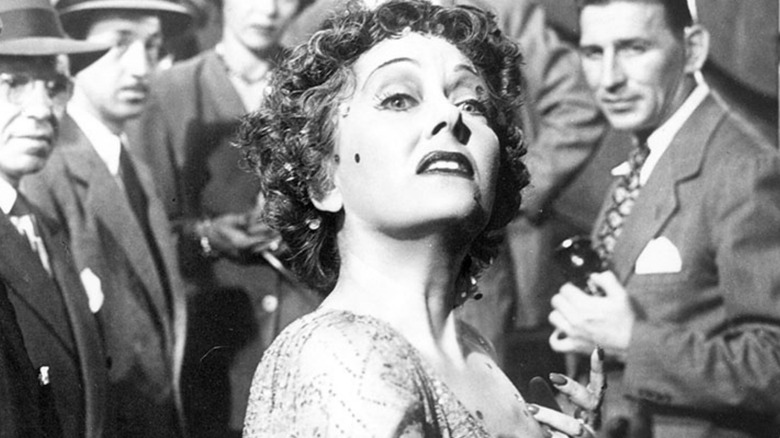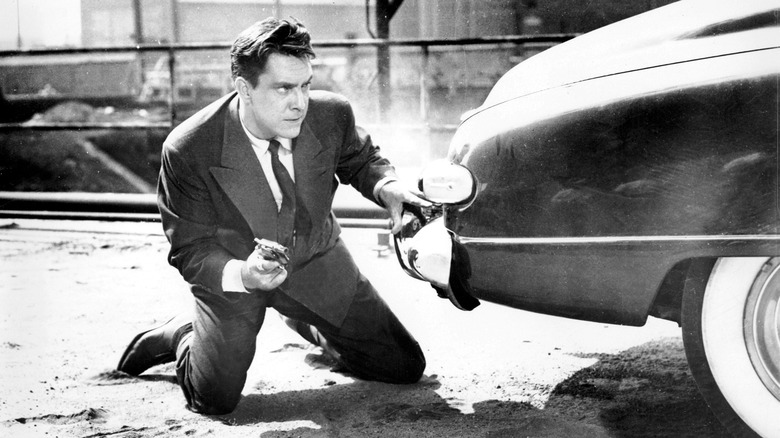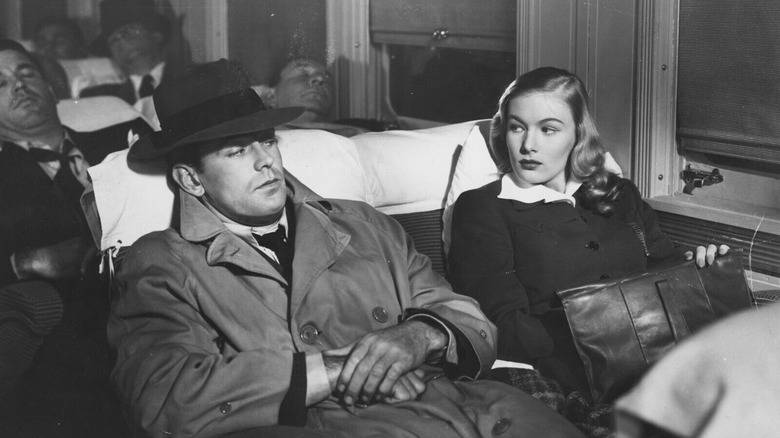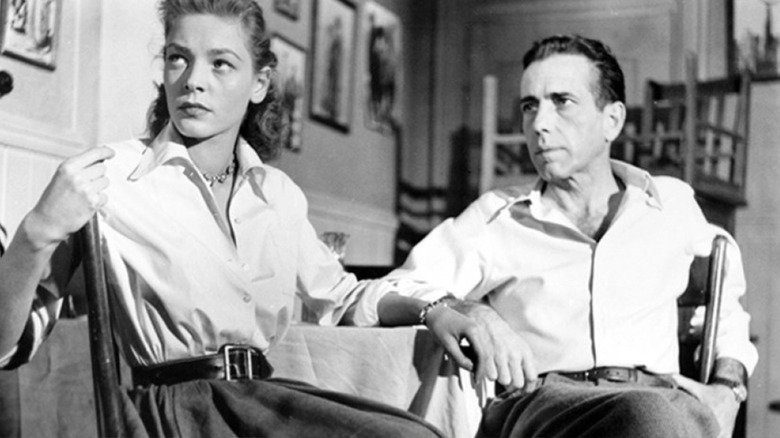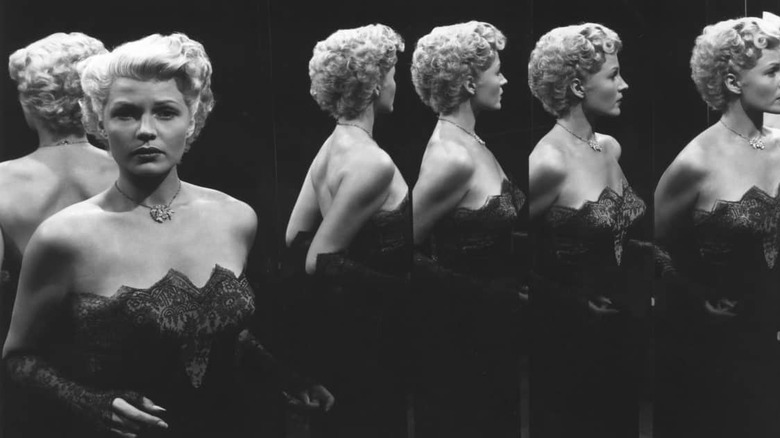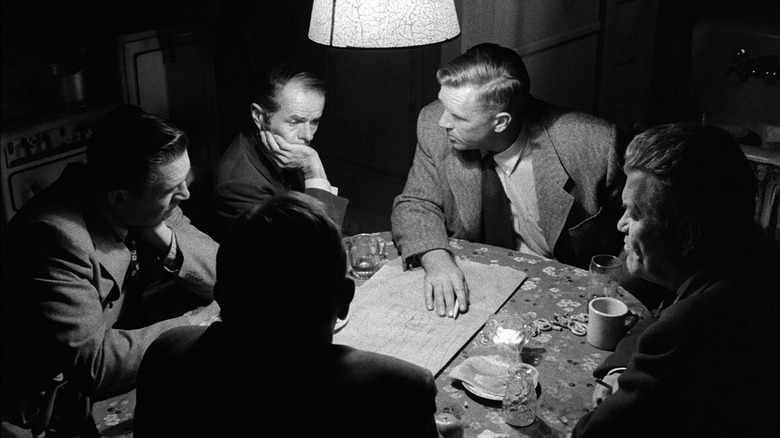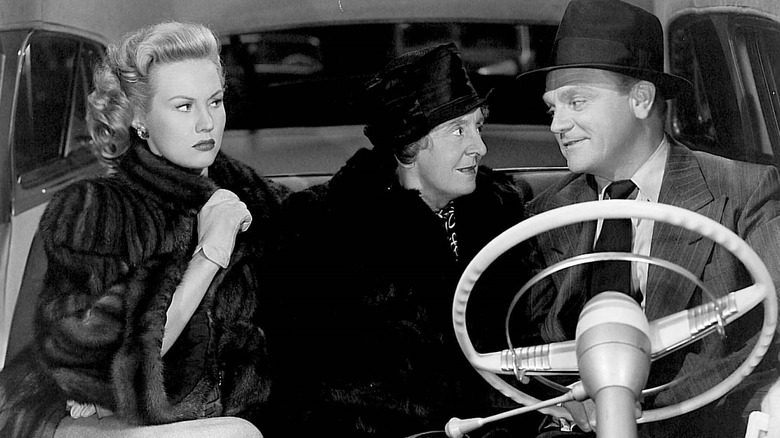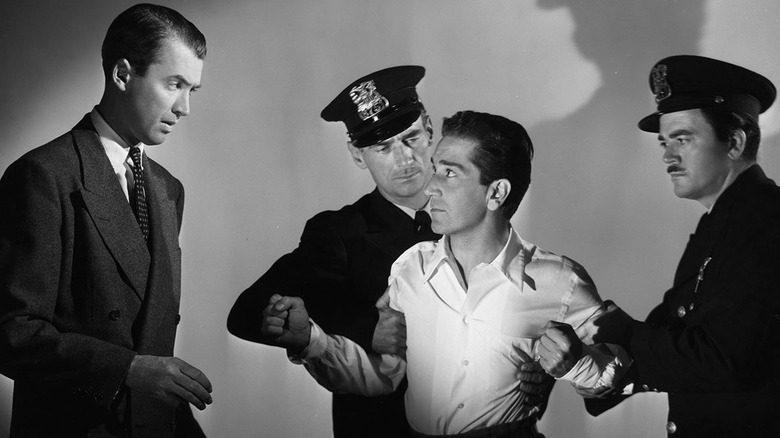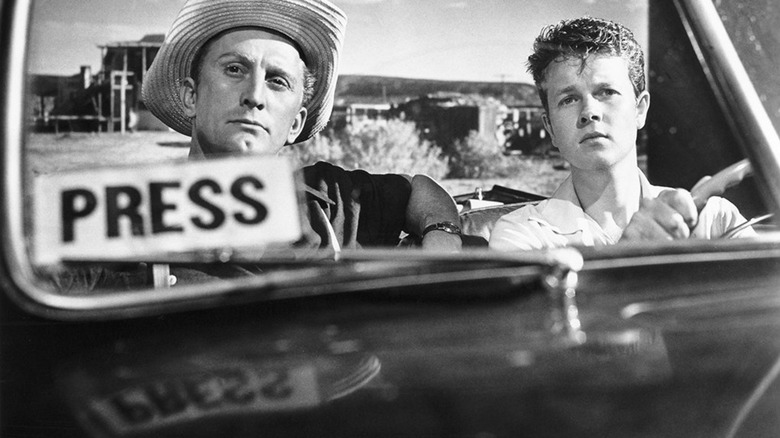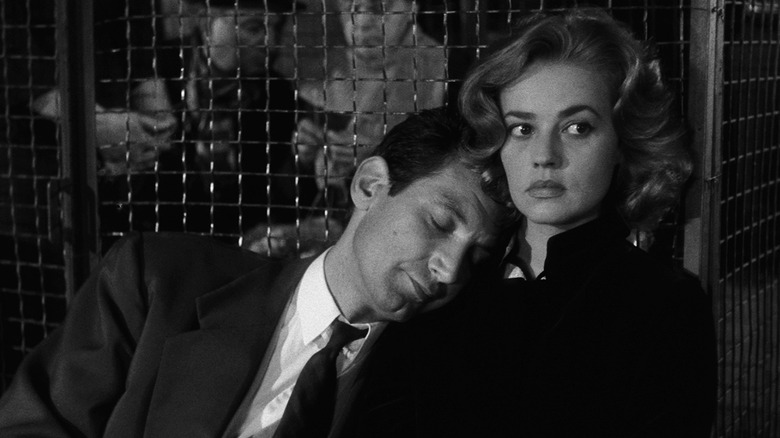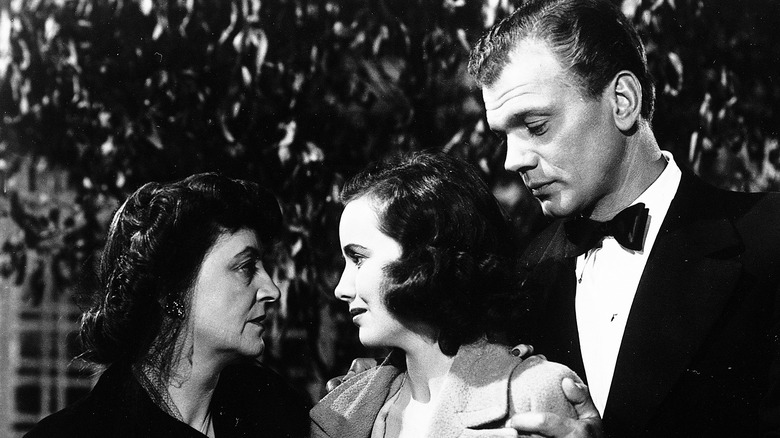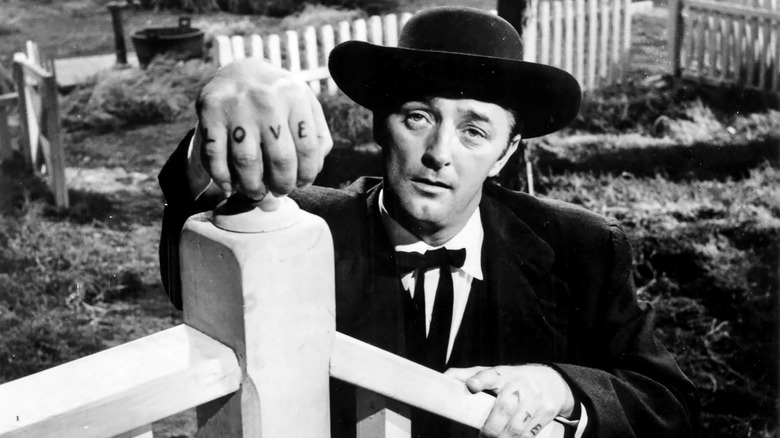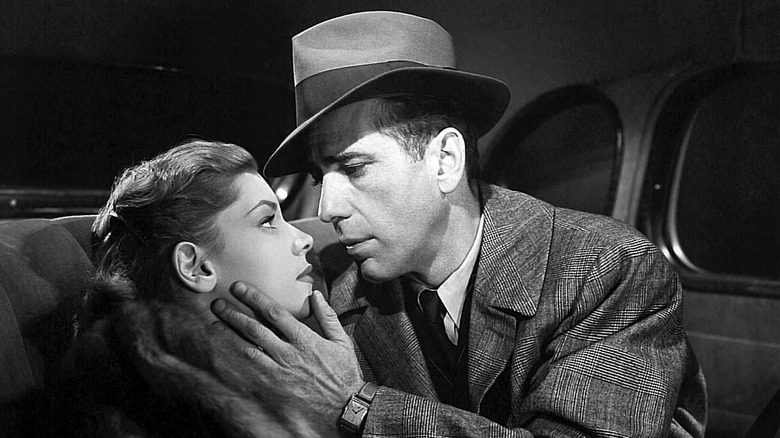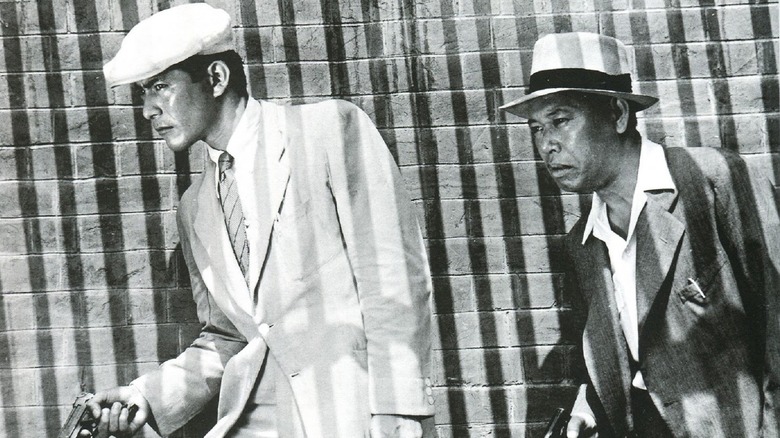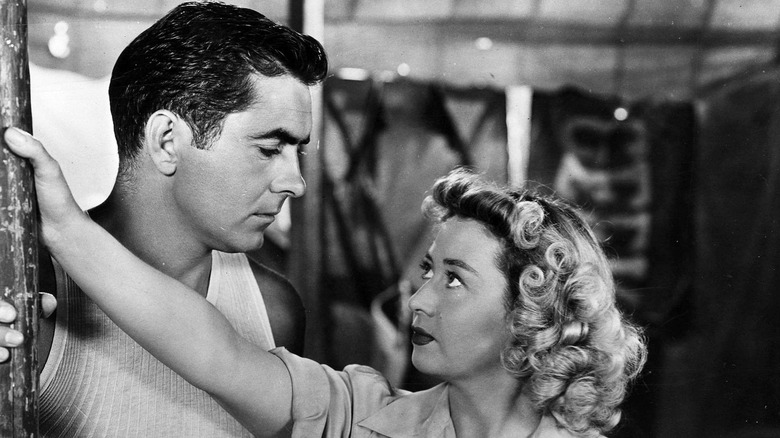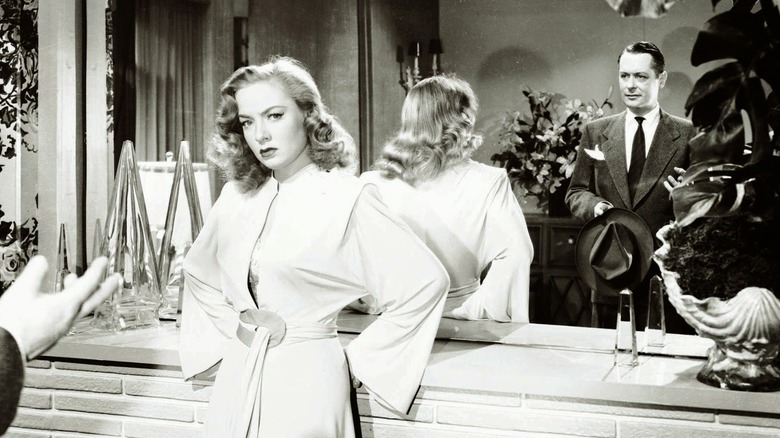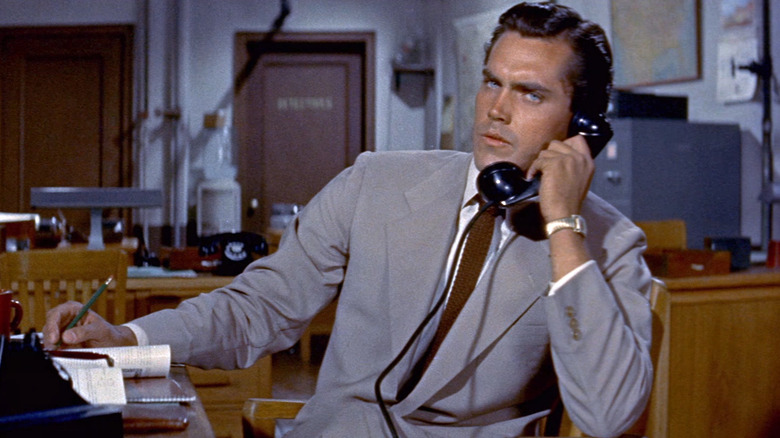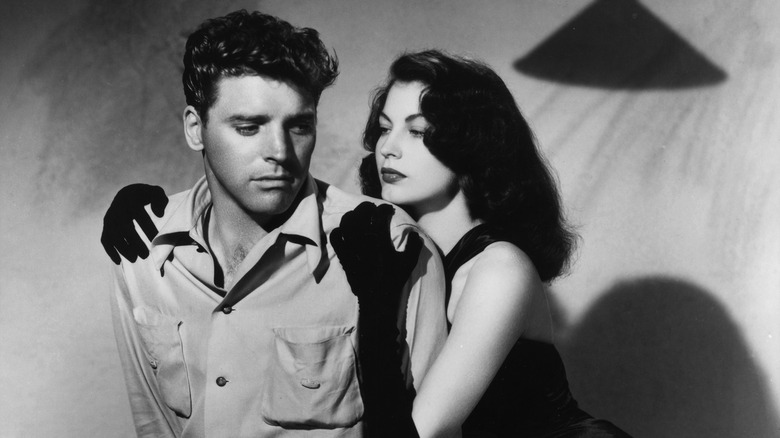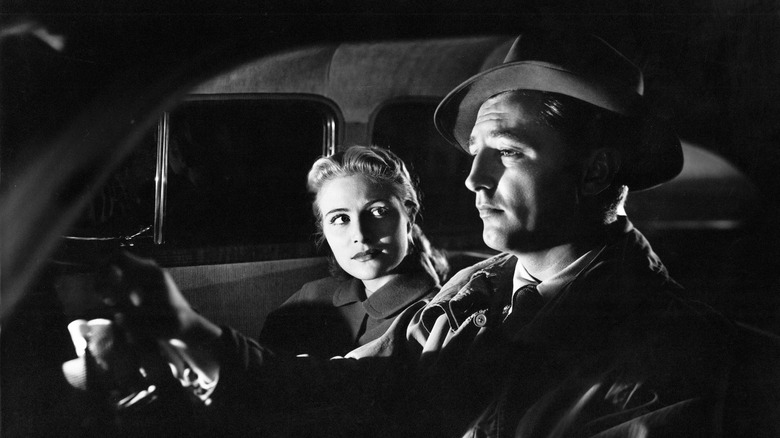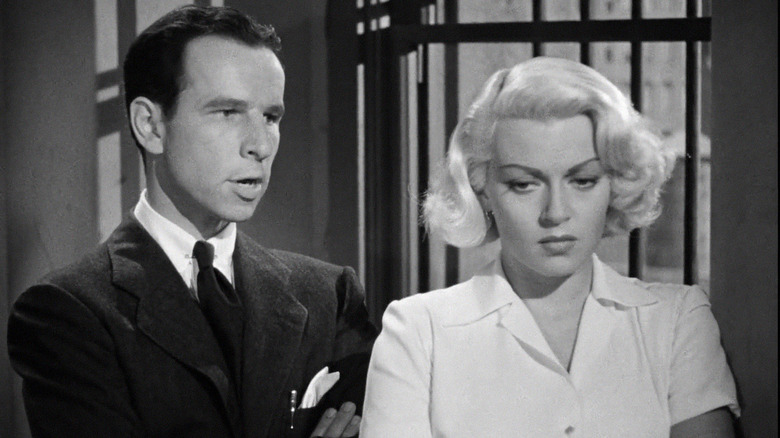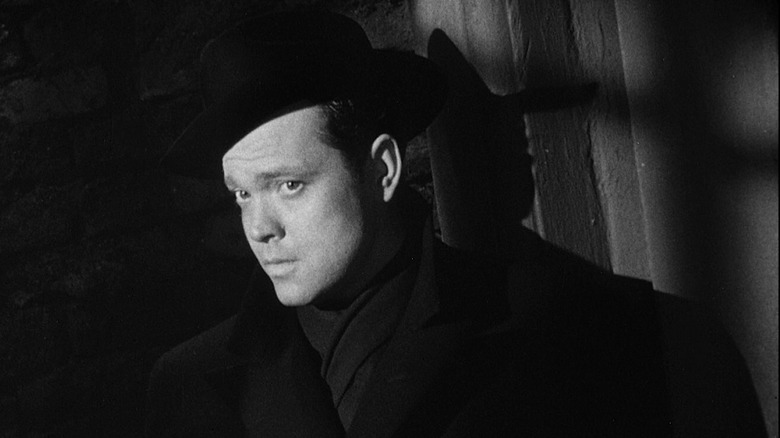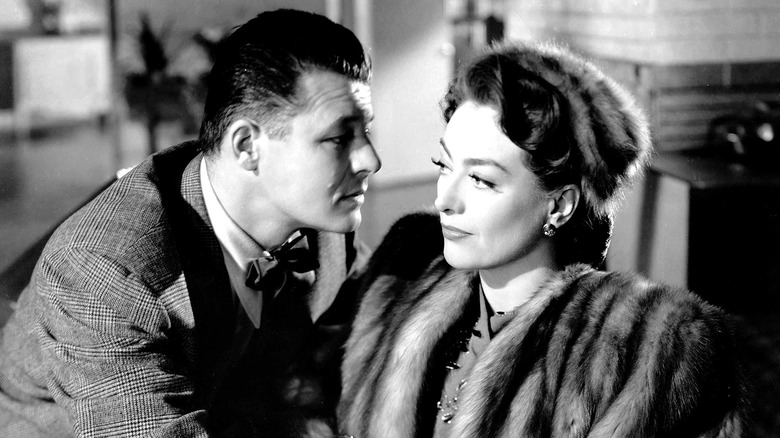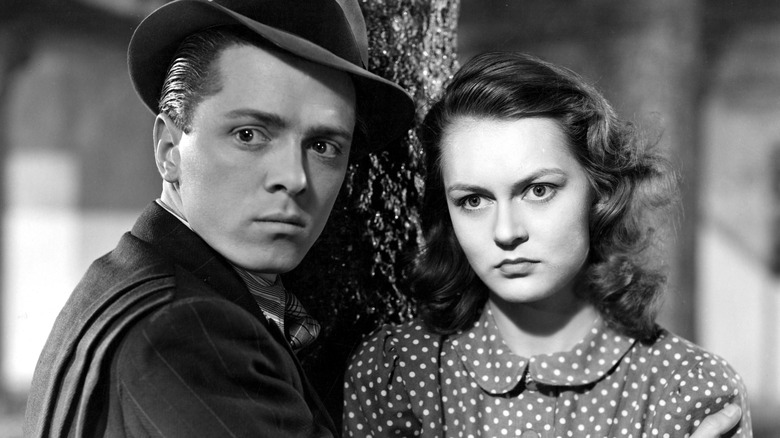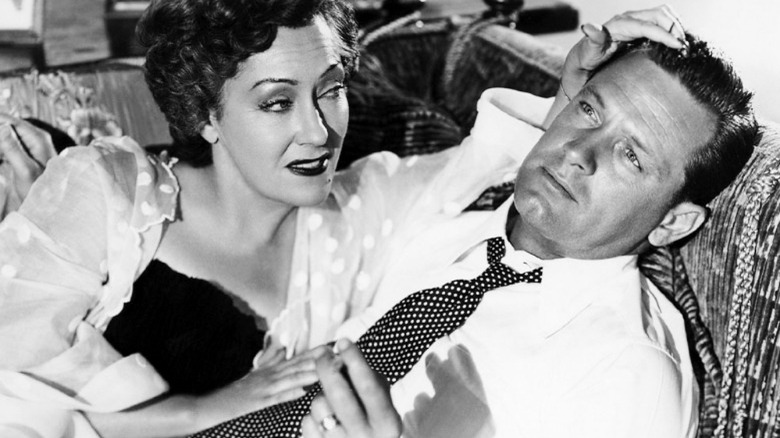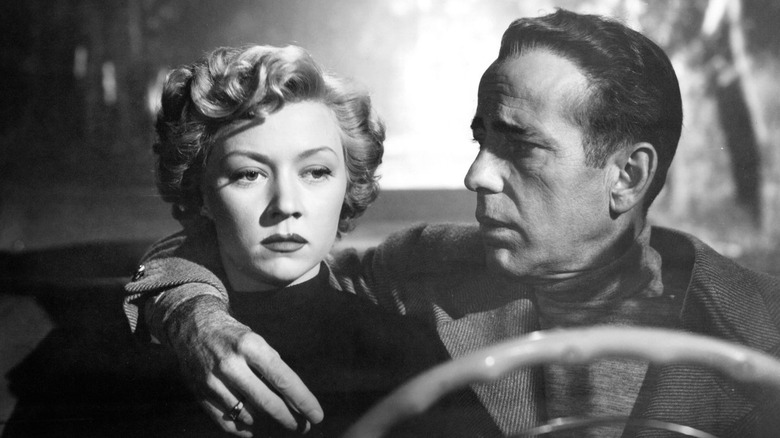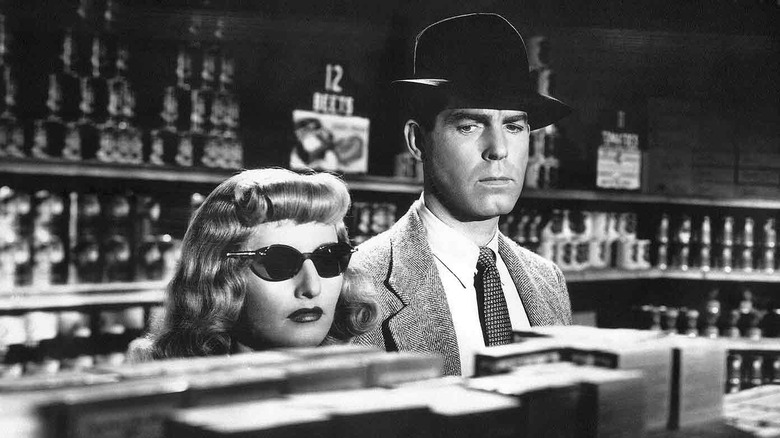The 25 Best Noir Movies Ranked
The hard-boiled detective, the femme fatale, the patsy, and the moll — by this point, the main ingredients of film noir might be considered cliches, but when its tropes are fully indulged, noir still leads to a great time at the movies. Frequently utilizing stunning black-and-white cinematography that emphasizes gorgeous lighting, shadows, silhouettes, and stark contrasts, noir films reveal the dark and seedy underbelly of post-war America (or, in some cases, Vienna, Tokyo, or seaside English towns).
As you'll see, the late 1940s were the golden age of noir. In addition, over half of the movies on this list are based on great pieces of pulp fiction by writers like Raymond Chandler, James M. Cain, Dorothy B. Hughes, Graham Greene, and Ernest Hemingway, proving that, if you have compelling characters and strong source material, you usually get a good movie out of it. Of course, it also helps if you're working with directors like Billy Wilder, Carol Reed, Akira Kurosawa, Jacques Tourneur, Michael Curtiz, and Howard Hawks.
So, shine your gumshoes, tip your fedora, light your cigarette, slug a shot of whiskey, and prepare to sink into a world of corruption and seduction, for these are the best noirs, ranked.
25. D.O.A.
"D.O.A." has one of the best framing devices of any noir (and that's saying something), as it begins with a man walking into a police station and reporting his own murder, then flashing back to a few days before. Edmond O'Brien's Frank Bigelow spends the movie's brisk runtime trying to solve the mystery of who poisoned him and why.
The nightclub scene in which Bigelow is poisoned is a compelling look into the "hip" music scene of the time, with beatniks getting thoroughly spaced out to the music, man. The mysterious poisoner wears a distinctive houndstooth coat and scarf — rare examples of men's costuming in a noir making an impact. The thrilling finale of "D.O.A" also makes brilliant use of one of the best-ever noir locations, the Bradbury Building in downtown Los Angeles. Bigelow finally manages to track down the man in houndstooth and shoots him on the stairs of the famous central atrium with its cast-iron filigree balustrades and wrought-iron 'birdcage' elevators.
"D.O.A." is very much a one-man show for O'Brien, who also has a supporting role in "White Heat." He is in every scene, following every possible lead as he tracks down the man responsible for his murder. It's a brilliant conceit, and O'Brien carries us through every thrilling step of the way.
24. This Gun for Hire
Veronica Lake divided her time equally between 1941 and 1942, making two all-time classic screwball comedies and two all-time classic noirs and cementing her status as an enduring Hollywood legend. "This Gun for Hire" was the first of four noir collaborations between Lake and Alan Ladd and was Ladd's star-making role. Ladd's chemistry with Lake overshadows Robert Preston, who was supposed to have the lead male role in the movie. Ladd shone so much during filming that it became clear that it would be him who people remembered.
Raven (Ladd) is introduced as a tough guy with a kitten, and Ellen (Lake) is a nightclub singer with a manager named McGillicuddy, who happens to be a monkey. The relationship between Raven and Ellen shifts during the film. From the moment they meet on a train, and he ends up falling asleep on her shoulder, they become inextricably bound, and their fates are sealed. At times, he is her rescuer, and at others, her kidnapper.
The most memorable section (which comprises much of the second half of the film) is when Raven takes Ellen hostage in a railroad yard as they are surrounded by police. They end up spending the whole night talking, and Raven reveals his past to Ellen. A stray cat comes in, revealing both sides of Raven's psyche — his compassion for loners like himself and also his sense of nihilism regarding his own life. It's easy to see why this was Ladd's breakthrough role. It's an astonishing performance.
23. Key Largo
While John Huston and Humphrey Bogart's best-known noir is their first collaboration, "The Maltese Falcon," some of us have a soft spot for the post-war movie they made in the unconventional noir setting of the Florida Keys. The sultriness of New Orleans and Florida would go on to be exploited during the neo-noir boom of the '80s and early '90s. In this respect, "Key Largo" was ahead of its time, capitalizing on the claustrophobic location of a hotel shut down for the summer due to the intense heat and the hurricane season. Like "Cat on a Hot Tin Roof," "Key Largo" was also adapted from a play, and both make wonderful use of their limited settings with simmering tensions brought to a boiling point.
Bogart plays reluctant war hero Frank McCloud, who drops in on James and Nora Temple (Lionel Barrymore and Lauren Bacall), the father and widow of his fallen comrade-in-arms. He discovers them in what is essentially a hostage situation. Their hotel has been commandeered by big-time gangster Johnny Rocco (Edward G. Robinson), his band of hoodlums (with colorful names like Toots, Curly, and Angel), and his permanently-soused moll, Gaye Dawn (Claire Trevor). A tense stand-off ensues while a hurricane rages outside.
Despite the circumstances, the chemistry between Bogart and Bacall is electric as ever, and Lionel Barrymore, as the wheelchair-bound James Temple, gives an affecting performance as a grieving father. "Key Largo" has a thrilling water-based finale in the Straits of Florida, with Bogart once again brilliantly portraying an everyday Joe forced into performing an act of greatness. "Key Largo" is a sizzling film noir.
22. The Lady from Shanghai
Orson Welles' forays into film noir are as legendary as the rest of his movies, from "The Stranger" to "Touch of Evil" to his impactful cameo in "The Third Man." "The Lady from Shanghai" is known for its behind-the-scenes controversies, with Welles being ordered to do extensive reshoots by Columbia Pictures, as well as the director telling his estranged wife, Rita Hayworth, to cut and bleach her famously luscious red locks for her against-type leading role.
Despite this, "The Lady from Shanghai" has much to recommend it, including one of the best femme fatales in Hayworth's Elsa. Although she is as white as can be, she represents a destructive, dangerous sexuality because of her time spent in China. She is contrasted by Welles performing in a lilting Irish brogue as the patsy at the center of an elaborate scheme. The locations range from New York to Acapulco to San Francisco's Chinatown, with a significant portion of the film taking place on a yacht.
The movie is best known for its hypnotically beautiful, climactic hall of mirrors sequence, which alone makes "The Lady from Shanghai worthy of its inclusion on this list. The scene has influenced James Bond and John Wick movies and more. There's another stunning scene that takes place at the Steinhart Aquarium in San Francisco, with creatures looming like monsters from the deep behind the silhouetted figures of Welles and Hayworth. "The Lady from Shanghai" is at the weird and arty end of noir and is an interesting example of the genre.
21. The Killing
It seems obvious that Stanley Kubrick would make one of the best noirs of all time, as he arguably reached the pinnacle of any genre he turned his hand to, including horror, science fiction, and the war movie. "The Killing" is a heist movie with an extremely intricate plot told out of order by a narrator who sounds like a racetrack commentator. Like many noirs, it's often best not to try to follow the plot too closely and instead enjoy the colorful characters and gorgeous visuals. The cast is led by Sterling Hayden, who brings a gang together for a racetrack heist. Their plan is laid out around a table very much styled to look like a poker game, with a low overhanging lamp that illuminates faces that try not to reveal too much.
Although "The Killing" is one of Kubrick's earliest films, his hallmarks are present in the film's visual precision. The blocking of the actors and how well-lit they are (even in chaotic scenes with many moving pieces) is nothing short of miraculous. Every frame is beautifully composed, which we should naturally expect from the director of "Barry Lyndon." The clown masks that some of the gang members wear during the heist create a monstrous image, the black and white photography draining them of the color that might dilute their horror. The dialogue was written by hardboiled crime writer Jim Thompson, which is why it's so good. The ending leans into the nihilistic and fatalistic themes often present in noir. "The Killing" is another triumph for Kubrick.
20. White Heat
James Cagney created his most iconic character in Cody Jarrett, a diminutive gangster who is the top dog in his underworld. It's a role very much comparable to Richard Attenborough's Pinkie Brown in "Brighton Rock" — both men are psychopathic, and ruthless when it comes to dispensing with anyone who gets in the way of their ambitions. The added layer to Cody's psyche in "White Heat" is his mother complex — she is the only person he cares about in the cold, cruel world he has created for himself.
The story is ingeniously plotted, but easier to follow than many noirs. Cody confesses to a lesser crime as an alibi for a major murderous crime, and is sentenced to a short stay in prison. Edmond O'Brien's undercover agent is planted in Cody's cell in an effort to gather information. Cody's traitorous right-hand man Ed, and his even more duplicitous wife Verna (a fantastic Virginia Mayo) betray Cody while he's in prison, and Verna commits the worst possible act — she murders Ma Jarrett.
Cody is the kind of psychologically complex, mentally ill character (who suffers from debilitating migraines), that we're more used to seeing women play. The fact that Cody maintains his position as a head honcho amongst his men (and instills fear in them), while still being "weak" in other areas — all makes for one of the most interesting gangster characters put to film. Like all of the best noirs, "White Heat" has an incredible finale — with Cagney's final line ending things on a high.
19. Call Northside 777
James Stewart isn't a name commonly associated with film noir, and when he did star in one, he did so in the most Jimmy Stewart way possible. Based on a real-life case, Stewart plays reporter P.J. McNeal who investigates an advert offering a $5,000 reward for information regarding a cop killing in 1932. This leads him to an elderly Polish woman named Tillie Wiecek (a scene-stealing Kasia Orzazewski), who, to prove her son Frank's (Richard Conte) innocence, earned the money scrubbing floors for over a decade. McNeal is initially skeptical, but the more he uncovers, the more he believes it.
"Call Northside 777" effectively conveys the chaotic atmosphere of prohibition-era Chicago and the extreme lengths the police and court systems would go to when one of their own was threatened. For the most part, the film is a compelling mystery in the best mode of investigative journalism movie, taking place in the world of 1930s and '40s crime. Institutional corruption in an immigrant community (in this case, Polish), where the pursuit of the American Dream has soured, is a major theme.
Stewart shares convincing chemistry with his onscreen wife, played by Helen Walker, and Lee J. Cobb shines as McNeal's editor. There are fantastic actors in even the smallest roles. The film is also notable for a scene that includes the inventor of the polygraph, Leonarde Keeler.
18. Ace in the Hole
At the opposite end of the scale from "Call Northside 777's" P.J. McNeal is Kirk Douglas as the wonderfully-named Chuck Tatum in "Ace in the Hole." With its unusual setting of New Mexico, "Ace in the Hole" may not appear to be a conventional noir on the surface, but its themes are perfectly in tune with the rest of the genre's themes. During and after WWII, many Americans realized that their once-trusted institutions, including the press, the legal system, and the government, were riddled with hypocrisy and corruption. Film noir was a reaction to this.
Kirk Douglas plays an ambitious reporter who has been fired by countless newspapers for his reckless ways. While holed up in Albuquerque (enduring what he considers a prison sentence), he embarks on a road trip and accidentally strikes gold. A man is trapped in a network of caves that the local Indigenous people believe is cursed. Tatum gets the first photos and quotes from the man, ensuring him exclusive access to the story. Hoping to secure re-election, the local sheriff also turns the accident to his advantage. With a literal carnival set up outside the caves, the situation turns into a three-ring circus.
The femme fatale is the trapped man's wife (played by Jan Stirling), who financially exploits the situation in her now-booming coffee shop. She sees Tatum as her ticket out of this one-horse town. "Ace in the Hole" is one of Douglas' best performances, and like all the best noirs, the film has a killer final shot.
17. Elevator to the Gallows
If you're looking for one film that perfectly bridges the gap between film noir and the French New Wave, look no further. "Elevator to the Gallows" has an ingenious plot but also allows time for Jeanne Moreau to wander the streets of Paris at night, looking beautifully despondent. While murdering his lover's husband, Julien (Maurice Ronet) becomes trapped in an elevator in his office building. Much of the film follows a pair of criminal lovers who steal Julien's car and commit a double murder. Julien becomes the chief suspect, despite his alibi of committing his own murder at the time.
Film noir is the most American of genres, but as can be seen from Japanese and British examples on this list, it's always interesting when other countries try their spin on it. "Elevator to the Gallows" is extremely French, with ennui and melancholy exuding from every pore of Moreau's Florence as she searches for Julien. The film takes place throughout one night, with time speeding up during the frantic chaos of the lovers on the lam and slowing in scenes with the lonely, despairing Florence.
"Elevator to the Gallows" is also probably the only noir, other than "The Third Man," to have a truly iconic score— in this case, improvised by Miles Davis and his collaborators. Jazz scores (mainly using saxophones) would go on to become a huge feature of the '80s neo-noir boom. If you want to take an excursion from the classic American noirs, this French gem directed by Louis Malle is a must-see.
16. Shadow of a Doubt
Alfred Hitchcock was such a prolific and dominant filmmaker that "Hitchcockian noir" is almost its own sub-genre. If you allow Hitch into lists of the best noirs, he can easily take over. Joseph Cotten's menacing Uncle Charlie is one of the greatest ever movie villains in "Shadow of a Doubt." A mysterious figure, he arrives at the home of his sister (Patricia Collinge) and niece (Teresa Wright), who is named after him. Young Charlie is delighted to see the tall, dapper uncle she idolizes but begins to suspect that he is the "Merry Widow Murderer."
Much of the film is spent with the two Charlies circling one another in a game of cat-and-mouse, always trying to out-maneuver one other and stay one step ahead. As young Charlie's suspicions grow, there are times when Hitchcock frames her as the predator and Uncle Charlie as the prey, as when she stands at the door with a long shadow stretching into the hallway. This is quickly followed by a Dutch angle of Uncle Charlie looming over us — a reminder that he's still very much a threat.
The supporting cast, including Hume Cronyn and Macdonald Carey as young Charlie's love interest, charmingly populate the idyllic small town. Charlie's younger siblings, Ann and Roger, are also great, though the 13-year age gap between Cotten and Collinge is a little distracting. "Shadow of a Doubt" has one of the best uses of gaslighting, a common theme in Hitchcock's work.
15. The Night of the Hunter
Charles Laughton's only movie as a director is an unquantifiable masterpiece that spans several genres, including Westerns and horror. "The Night of the Hunter" is one of the best American takes on German Expressionism, and it centers on a bone-chilling performance by Robert Mitchum as Harry Powell. This stunning film is full of indelible images, the most haunting of which is Willa's (Shelley Winters) murder and the disposal of her body in a car at the bottom of a river. Her hair waving with the reeds in the water is haunting. The casting of silent movie star Lillian Gish in the impactful role of Rachel Cooper (who stands her ground against evil Preacher Powell) inspired Laughton to make the film as close to a silent movie as possible.
"The Night of the Hunter" has some of the best black-and-white cinematography of all time, with cinematographer Stanley Cortez emphasizing stark contrasts through his compositions and lighting. Laughton also focuses on the child's point of view in many scenes, simplifying the production design to details that children would focus on and remember. At times, the film seems like a pared-down theatrical production. Billy Chapin as John Harper gives an incredible performance as the skeptical child who is the only person who sees through Powell from the beginning. Mitchum is perfectly cast as the seductive sociopath who uses his Southern preacher's drawl to spout homespun wisdom, masking the evil within. He's one of the scariest movie villains of all time and contributes to this film's deserved reputation as an all-time great.
14. The Big Sleep
Humphrey Bogart playing Philip Marlowe, Chandler's iconic private eye, is as classic as noir can get. In this adaptation of Raymond Chandler's most famous movie, Bogie and Lauren Bacall shine as Marlowe and Vivian Sternwood, the daughter of the man who hires him, respectively. While the convoluted plotting works better in the book than on film, "The Big Sleep" really comes alive during their shared scenes, with their obvious chemistry bringing the heat. Marlowe feels like the role that Bogart was born to play, but it's Bacall who brings out the best in him.
The opening of the film, in which Charles Waldron's dying General Sternwood talks about the hothouse lilies warming his blood, is a highlight, as is John Ridgely as Marlowe's foil, the racketeer Eddie Mars. Martha Vickers as the sexually provocative Carmen Sternwood also pushes boundaries, as much as was possible at the time.
The dialogue in a Chandler adaptation is always going to its biggest selling point, and much of the classic noir tropes come from this film. Director Howard Hawks is better known for his screwball comedies and westerns, but his foray into noir helped establish the foundation that later productions built on.
13. Stray Dog
While he is of course best-known for his samurai films, Akira Kurosawa also made several noirs (including two in the 1960s) that rank among his best work. "Stray Dog" is set in a sweltering post-war Tokyo and sees two mismatched detectives team up to solve a crime, a trope we will see return in "Memories of Murder," as well as a whole raft of Hollywood films, such as "Lethal Weapon."
The duo is played by regular Kurosawa collaborators Toshiro Mifune and Takashi Shimura. Detective Murakami (Mifune) has his gun stolen on a bus and spends the rest of the film trying to track it down, feeling emasculated and wracked with guilt about the future crimes it becomes involved in.
Kurosawa shot on location in the real war-ravaged streets, and while the film was only made a few years after 1945, there is some sensitive handling of traumatized men trying to regain their lives after the war. The opening close-up shots of Murakami on the bus are brilliantly claustrophobic, with the narration telling us that "the air was so thick, he felt woozy." The crowd shots at a baseball game are also expertly handled. Even now, "Stray Dog" feels hugely ahead of its time.
12. Nightmare Alley
This film has been the subject of renewed interest recently, due to the fact that Guillermo del Toro's remake comes out in 2021. In this 1947 adaptation, Tyrone Power takes on the role of his career as an ambitious carny who achieves lofty heights before a spectacular fall brought on by his own hubris.
"Nightmare Alley" is a complex film that has many different sections. The early part of the film is set at a carnival, focusing on Stan (Power) and his professional (and personal) relationship with his mentor, the clairvoyant Zeena (Joan Blondell). He then moves onto the naive Molly (Colleen Gray), whom he marries before taking what he's learned from Zeena and becoming a successful nightclub act.
But Stan is wracked with guilt for the part he played in Zeena's husband's death and visits a psychologist (Helen Walker). They strike up a deal to use the information she has gathered about her patients to exploit people. There is an extraordinary scene in which Stan convinces Molly to pose as the dead love of a grief-wracked older gentleman.
Power is sensational in the central part, and the three women in supporting roles are also extraordinary. The recurring role of the carnival "geek" also makes for a heartbreaking way to bookend the narrative.
11. Lady in the Lake
Considered by most to be a failed experiment, Robert Montgomery's adaptation of Chandler's "Lady in the Lake" is so weird that I can't help but have huge affection for it. If you're not enticed by the tagline — "YOU and Robert Montgomery solve a murder mystery together!" — then you must not like fun (or Choose Your Own Adventure books). It's also a Christmas film!
Montgomery directs and stars as Philip Marlowe, but barely appears on screen, due to the film being shot from his point of view. This means that everyone else's performances, including the deliciously melodramatic Audrey Totter as Miss Fromsett, are pitched directly at the camera. It takes some getting used to, but lean into it and you'll have a good time. Totter's eyebrow work alone is worth the price of admission.
One of the other unusual aspects of this movie is that the only score is a sparingly-used vocal chorus. The film is also surprisingly romantic, given that Totter has to make love to the camera throughout. This adaptation doesn't work for everyone, but I love bold, risky, unique approaches to films like this. "Lady in the Lake" is a very strange entry into the noir canon, but one that's definitely worth watching at least once.
10. A Kiss Before Dying
"A Kiss Before Dying" is the odd one out on this list for three reasons: It's the only color movie, it's set in Tucson, Arizona, and it's from the mid-'50s. And yet, I had to include "A Kiss Before Dying" here. It has a bold plot that takes some unbelievable twists and turns, and centers on a truly memorable villain.
Robert Wagner plays Bud Corliss, a cold and calculating university student who is after the fortune of Leo Kingship (George Macready), a mining mogul. First, Bud woos Kingship's daughter Dorothy (Joanne Woodward), but in a bold move for a film of the time, she becomes pregnant. Bud worries that she'll be disinherited, and so agrees to meet her at the office where she believes they'll be married and pushes her off the roof instead, making it look like she took her own life.
Bud quickly targets Dorothy's younger sister, Ellen (Virginia Leith), who is unaware that he had a relationship with Dorothy. Jeffrey Hunter appears as Gordon Grant, a man who becomes suspicious of Dorothy's death and starts to investigate the matter, leading to an exciting, action-packed finale that takes place at the Kingship mine. Many of the best noirs focus on twisted, villainous individuals; even among the most depraved, Bud stands out as one of the worst.
9. The Killers
You know you're about to get into the juicy stuff when someone drifts off with a wistful "It all started when..." Well, we get that several times here, as the people who knew "the Swede" (a young and very beautiful Burt Lancaster) reminisce about his life after he's shot by two hitmen. Once again, a dope is undone by his love of a beautiful woman — here, the radiant Kitty Collins (Ava Gardner). Lancaster and Gardner make for one of the hottest ever doomed couples at the center of a noir, and for that reason alone, it deserves its place on this list.
The only flaw of "The Killers" is that the extremely compelling Lancaster doesn't get enough screen time, due to being, well, dead. But he makes enough of what he has to give us a reason to care about the investigation into his death. Edmond O'Brien plays Reardon, the dogged insurance investigator who can't let the case go. Like many noirs, "The Killers" has a dynamite opening, with the killers arriving at a diner and quickly changing the atmosphere to frosty. Also? "Don't ask a dying man to lie his soul into hell" is a killer (ahem) final line.
8. Out of the Past
Another noir with a great framing device, "Out of the Past" is about a man trying to escape his old life by changing his name and moving to a one-horse town. Like many noir protagonists, Jeff (Robert Mitchum) is undone by his love of a low-down, no-good, double-crossing broad — in this case, Kathie (Jane Greer).
There's a great juxtaposition between Jeff's old life, which revolved around gangster Whit Stirling (Kirk Douglas), and his new one with his wholesome girlfriend, Ann (Virginia Huston), and a kid (Dickie Moore) who helps him run the garage where he's trying to make an honest living. When these two lives start to bleed into one another, trouble starts.
Mitchum is as close to a perfect noir vessel as it's possible to be — his floppy hair, hooded eyes, and large, gangly frame just work as a man torn between the lure of small-town America and the more enticing, exciting prospects of a life of crime. It's extraordinary that he can be so perfect here and play the embodiment of evil in "The Night of the Hunter." Like all the best noirs, "Out of the Past" also has a stupendous ending.
7. The Postman Always Rings Twice
Once Lana Turner makes that entrance, you know it's curtains for poor John Garfield. "The Postman Always Rings Twice" is an unpredictable ride that you think is about one thing, but ends up quite different. The first half involves Cora (Turner) and Frank (Garfield) plotting to murder Cora's older husband, Nick. So far, very "Double Indemnity."
But at the point at which most noirs would end — when the couple gets caught — this movie still has nearly half its runtime to go. The real stars of the show are two lawyers, DA Kyle Sackett (Leon Ames, who is also in "Lady in the Lake") and Arthur Keats (Hume Cronyn), who somehow shake it so that the lovers go free. And then the movie keeps going...
"Postman" strikes the balance between being extremely twisty while also being easy and satisfying to follow. No one really fits into the prototypical noir archetypes, either. Lana Turner is luminous in her white silk outfits (something later replicated by Kathleen Turner in "Body Heat") and the plot is propulsive, with a deliciously ironic ending.
6. The Third Man
Not many noirs are known for a signature tune, but "The Third Man" features one of the most famous pieces of film music ever written. It's also easy to forget that Orson Welles' Harry Lime only has a small amount of screen time, because his presence is felt so heavily throughout. He both makes an all-time great entrance, and also gets an all-time great death scene.
Joseph Cotten, who made such a sinister impression in Hitchcock's "Shadow of a Doubt," plays the everyman who carries the film, aided by Trevor Howard's Major Calloway. They spend the film pursuing the enigmatic Lime as he slides like a slippery eel through the alleyways and sewers. Other than his entrance and exit, Lime gets just one other iconic scene, which takes place on a Ferris wheel and includes his famous line about the cuckoo clock.
But it is Anton Karas' music and Robert Krasker's cinematography that are the stars of the show. The Dutch angles, the silhouettes, and the shadows are absolutely stunning throughout. The film is relentlessly cynical and bleak, capturing the brief moment between the end of World War II and the start of the Cold War. It's another rare example of a non-American noir that is so flawless that it must be enveloped into the canon of all-time great noirs.
5. Mildred Pierce
If there's one thing that noir loves, it's a cold open. This one has a doozy. Shots are fired, a man goes down, and his last word is "Mildred." In addition, the scene near the start where Mildred (Joan Crawford) invites Willy (Jack Carson) back to her beach house to make a patsy of him is one of the most gorgeously shot scenes in noir; the light and shadows, angles, framing, and blocking are all exquisite.
The other thing that noir loves is a framing device, and the one in "Mildred Pierce" starts a full 20 minutes in, as Mildred starts to regale the police with her tale — cue the flashback. The femme fatale of the piece comes from an unexpected source: Mildred's 16-year-old daughter Veda (Ann Blyth), who has her mother over a barrel.
Considering that much of the film is a domestic drama concerning Mildred's pursuits as a successful businesswoman, it's remarkable how "Mildred Pierce" still manages to have the look of a noir throughout. With Michael Curtiz at the helm, it's no wonder that it's phenomenally directed. Crawford acts the hell out of the title role, while being beautifully shot by Ernest Haller at all times. "Mildred Pierce" is a cracking story (originally written by James M. Cain) that is enhanced by Curtiz's direction — it's a genuine masterpiece.
4. Brighton Rock
If you haven't seen Richard Attenborough in the seedy British noir "Brighton Rock," you are in for a revelation. Forget the kindly grandfather in "Jurassic Park." Here, Attenborough delivers an all-time great performance as the sociopathic Pinkie Brown, a murderous teenage gangster who will go to any lengths to save his own skin, no matter who gets in his way.
One of these impediments is the wonderful Hermione Baddeley as Ida, a woman who encountered Pinkie's victim and is determined to avenge him. Another witness who needs to be dealt with is the sweet and innocent Rose; Pinkie realizes that, if he marries her, she cannot testify against him.
There are many highlights in this film, and director John Boulting and cinematographer Harry Waxman make sure they leave a lasting impression: Pinkie using the cover of a "ghost train" to perform a murder; Pinkie pushing a man off a balcony, the aftermath reflected in a skylight; Pinkie revealing his true feelings about his new bride on a recording — "I hate you. You make me sick" — while her angelic face is right there, outside the booth. Not many noirs from outside the U.S. rank among the greats, but this is certainly one of them.
3. Sunset Boulevard
Gloria Swanson delivers one of the greatest performances of all time as Norma Desmond, a symbol of the faded glamor and broken dreams that settle in once the spotlight fades and fame fizzles. "Sunset Boulevard" also features a great noir trope, as a dead guy narrates the circumstances that led to his death; the film opens not only with a corpse in a pool, but with a deceased chimpanzee who needs an appropriately-sized coffin.
As Joe, an aspiring screenwriter who becomes a kind of captive gigolo for the vulnerable Desmond, William Holden is a great foil for Swanson. Norma lives in a full-on Gothic castle, complete with a windy pipe organ and a manservant named Max. Joe's narration is filled with incredible writing; lines like "She was still waving proudly to a parade that had long since passed her by" are classic noir.
Having real-life figures such as Cecil B. DeMille, Hedda Hopper, and Buster Keaton appear (in addition to references to many more directors, writers, and stars) fully soaks the film in Hollywood lore. "Sunset Boulevard" is a fantastic noir because it has that pulsing sense of inevitability. Joe's everyman is led to his doom, and Desmond is up there with Blanche DuBois as an all-time great character for a woman of a certain age.
2. In a Lonely Place
As with "Brighton Rock," "A Kiss Before Dying," and maybe "Nightmare Alley," the main character here is also the villain of the piece — or is he? Both "Brighton Rock" and "In a Lonely Place" are based on exceptional books that take you into the mind of sociopathic killers. However, "In a Lonely Place" differs substantially from Dorothy B. Hughes' book, making Dix Steele (Humphrey Bogart) more complex, and the audience is less sure if he is evil or not as a result. The movie is also about Hollywood in a way that the book is not.
The movie is still unusual in that it centers on such a dark and violent character, with the big star taking on this role rather than that of the good cop Brub Nicolai (Frank Lovejoy). Laurel (Gloria Grahame) is the innocent woman who becomes embroiled with a dangerous man, and then becomes too scared to leave him.
Grahame's performance is all the more extraordinary, given that she was separating from her husband, the film's director, Nicholas Ray, during filming. Check out the 2018 movie "Film Stars Don't Die in Liverpool" for a fascinating companion piece. Bogie also delivers one of his best performances as an unpredictable wild card who can explode into rage at any moment.
1. Double Indemnity
It's a tough call, but Barbara Stanwyck, who was also a gifted comedienne, may have created the ultimate femme fatale in Phyllis Dietrichson. "Double Indemnity" is the third movie on this list based on a novel by James M. Cain (the others being "Mildred Pierce" and "The Postman Always Rings Twice"). Fred MacMurray plays Walter Neff, the patsy in Dietrichson's scheme to murder her husband and claim the insurance money.
It works very well that McMurray was clearly foot taller than Stanwyck, while she is the one holding the power and pulling the strings. Their frequent rendezvous in a local market, where Phyllis wears dark glasses and they attempt to communicate without looking at each other, are brilliant. Their initial meetings in the Dietrichsons' fabulous Spanish colonial home are a masterclass in flirtation and seduction. MacMurray walks the tightrope between being an intelligent man who comes up with ingenious schemes and the doomed fool who is hoodwinked, bamboozled, and led astray by an ambitious and ruthless woman.
The top three films on this list are all set in Los Angeles. As Thom Anderson says of "Double Indemnity" in the wonderful documentary "Los Angeles Plays Itself," "You could charge L.A. as a co-conspirator in the crimes this movie relates." Los Angeles is the ultimate noir setting, and "Double Indemnity" is perhaps the ultimate noir.
